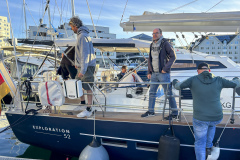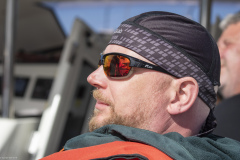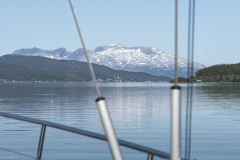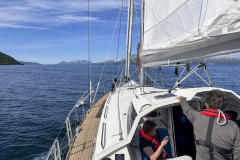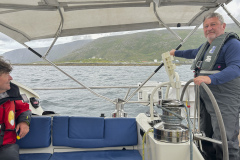Spitsbergen 2024 – A special adventure with the POLARIS (Part 1)
from Guido Dwersteg
The preparations for our latest sailing adventure were literally long and arduous. This time our destination was to be particularly far north, on Spitsbergen to be precise. An area that places special demands on man and material. Added to this are the extensive official requirements that have to be fulfilled and clarified in advance.
As far as our POLARIS is concerned, most of the necessary technical preparations had already been completed after the winter storage in Bodø. In addition to a major service for the engine, our dual redundant hot water heating system was also put through its paces once again and a Starlink system was installed on board for communication far away from civilisation. In addition to the existing VHF, Iridium and short wave system, this is a further component for safety and comfort on board our Garcia Exploration. An additional dinghy made of hard plastic was also purchased. The reason for this was the foreseeable rough coastline with jagged rocks and stones as well as the additional safety against damage from polar bears. We lashed our previous dinghy to the foredeck of our expedition yacht as a backup just in case. Of course, we also had to adapt our personal equipment to the new requirements. In addition to survival suits for all crew members and guests, we also purchased a portable emergency dinghy, which would bring at least one person safely back to the POLARIS if our normal dinghy was damaged.
The necessary “paperwork” not only included registering with the Sysselmester (the governor of Spitsbergen), but also a detailed presentation of our plans with all conceivable information, such as the planned routes and shore excursions. Crew lists were just as much a part of this as the application for a hire gun and alcohol licence. Both are handled very restrictively on Spitsbergen. The weapon is mandatory for all types of shore leave and serves as protection against attacks by polar bears. In this context, we also purchased two additional anti-aircraft guns on site for firing alarm and flare ammunition. Our skippers had already acquired the relevant certificates of competence in Germany. Last but not least, we had to take out insurance suitable for the North Sea, including salvage.
All in all, the whole procedure took a few months. Eventually, however, everything was finalised and we were able to set about realising our big goal. The starting point of our ferry trip to Spitsbergen was the northern Norwegian town of Tromsø. A place steeped in history from which numerous expeditions to the north have started in the past. Our POLARIS had already travelled this far on various trips with guests.
Together with owner and skipper Uwe, we flew to Tromsø at the end of June 2024. We boarded the boat one day later in perfect weather. After taking over from foreskipper Clemens, we did some final work on the ship and stowed the additional equipment we had brought with us. Our first crew was due to come on board the very next day. A total of 5 guests plus skipper and co-skipper.
We had already drawn up a rough plan for our trip to Spitsbergen in advance. Firstly, we were to sail through the sheltered inner waters of northern Norway up to Torsvag, a tiny fishing harbour on the north-west coast of the Norwegian mainland. From here, the planned route took us out onto the open sea. Depending on the wind and weather, we then had to cover the 500 nautical miles to the south coast of Spitsbergen with a stopover on Bear Island about halfway. A trip of about 4 to 5 days. The weather itself promised good sailing conditions with stable winds of around 5-6 Beaufort from west to south-west.
The next day was the day. Our guests arrived at the jetty one by one and then moved into their cabins and berths. This was followed by more extensive provisioning this time. After all, we wanted to be independent for the next 6-8 days before we could stock up on new provisions in Longyearbyen – the main town on Spitsbergen. So we stowed vast quantities of food and drink in every conceivable corner of the POLARIS. At first I was afraid that we wouldn’t be able to fit it all in. But our Garcia is a real space miracle in this respect. Everywhere there is still a corner or drawer where you can store something. We spent our last evening in Tromsø in a cosy restaurant and really enjoyed ourselves once again.
We set off with the tide the next morning. Our general course for the next few hours was now NORTH to NORTH-EAST. Through the partly wide but also narrow fairways north of Lofoten, we headed under engine towards Torsvag. Unfortunately, sailing is only rarely possible here, as the inner fairways are very strongly shielded from the sea wind by the surrounding mountains. When there is wind, it is very changeable or sometimes right on the nose. The distance was about 50 miles until we reached the fishing harbour of Torsvag in the early evening and tied up the lines. There wasn’t much going on here. A handful of fishing boats rocked on the jetty and there were no people to be seen for miles around. Why would there be? After all, it was Sunday and therefore closing time … even for the otherwise lively fishermen. Due to the lack of infrastructure on land, we then had a cosy evening on board, where our crew, and in particular regular guest Marco, was able to demonstrate his culinary skills as a trained chef. And even at this still fairly manageable altitude to the north, it wasn’t really dark at night. Of course, this was to increase significantly as we travelled further north, right up to the famous midnight sun.
Our long crossing started the next morning at around 10am. Beforehand, we had a short crew briefing in which we explained our plan once again and pointed out the necessary safety measures. Then we finally set off. Close to land, the forecast wind was still a little slow, which is why we first had to gain some distance from the coast under engine power. However, we were soon able to set sail and consistently stayed in the first reef. After all, the wind was forecast to increase to 7 Beaufort in gusts. And that’s exactly what happened. The breeze increased from hour to hour and gave us a sometimes rough but fast ride.
As is usual on a long leg, it takes some time for all crew members and the skipper to get used to the long-distance rhythm. In the beginning, it is always unfamiliar and exhausting to do everything in heeling and swell. This also applies to everyday things like sleeping, cooking and going to the toilet every day. We had also drawn up a watch plan for the upcoming miles. Of course, each watch was supervised and managed by one of our skippers. However, the crew were also called upon to help with manoeuvres, lookout duties and other tasks on board. So it was time for the first “night”. As I said, you can’t really call it night, as it was no longer dark and this phenomenon intensified as we travelled further north.
The wind had now levelled off at a stable 6-7 Beaufort, interrupted by a few short periods of calm. The swell was steadily increasing and in the meantime the highest waves were sure to reach the 4 metre mark. Our POLARIS loves these conditions. With a good average speed of around 7-8 knots, we sped northwards. Here and there, however, a little nausea crept in among our guests. Especially after co-skipper Guido proved his cooking skills with a champion cream soup :-). However, nobody really got seasick and once you’ve fed the fish, it usually gets better anyway.
There wasn’t much shipping traffic on our journey north. The only encounters we had on the high seas were with a large fishing trawler and a cruise-style ferry. However, we already had regular visits from large and small fish, dolphins and whales. Seabirds were also always around us during the passage. Sometimes we almost had the feeling that a few feathered inhabitants of Torsvag wanted to accompany us on our way to Longyearbyen. After about 48 hours of travelling, the time had come. The rugged outline of Bear Island appeared on the cloudy horizon. Our first stopover was now right in front of us. It remained to be seen whether we could really anchor here in the strong winds and swell.
WOULD YOU LIKE TO EXPERIENCE SUCH AN ADVENTURE ON THE POLARIS?







